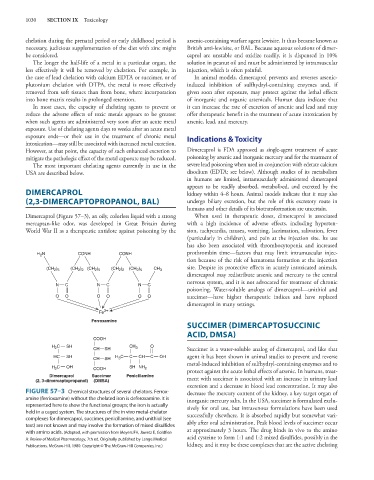Page 1044 - Basic _ Clinical Pharmacology ( PDFDrive )
P. 1044
1030 SECTION IX Toxicology
chelation during the prenatal period or early childhood period is arsenic-containing warfare agent lewisite. It thus became known as
necessary, judicious supplementation of the diet with zinc might British anti-lewisite, or BAL. Because aqueous solutions of dimer-
be considered. caprol are unstable and oxidize readily, it is dispensed in 10%
The longer the half-life of a metal in a particular organ, the solution in peanut oil and must be administered by intramuscular
less effectively it will be removed by chelation. For example, in injection, which is often painful.
the case of lead chelation with calcium EDTA or succimer, or of In animal models, dimercaprol prevents and reverses arsenic-
plutonium chelation with DTPA, the metal is more effectively induced inhibition of sulfhydryl-containing enzymes and, if
removed from soft tissues than from bone, where incorporation given soon after exposure, may protect against the lethal effects
into bone matrix results in prolonged retention. of inorganic and organic arsenicals. Human data indicate that
In most cases, the capacity of chelating agents to prevent or it can increase the rate of excretion of arsenic and lead and may
reduce the adverse effects of toxic metals appears to be greatest offer therapeutic benefit in the treatment of acute intoxication by
when such agents are administered very soon after an acute metal arsenic, lead, and mercury.
exposure. Use of chelating agents days to weeks after an acute metal
exposure ends—or their use in the treatment of chronic metal Indications & Toxicity
intoxication—may still be associated with increased metal excretion.
However, at that point, the capacity of such enhanced excretion to Dimercaprol is FDA approved as single-agent treatment of acute
mitigate the pathologic effect of the metal exposure may be reduced. poisoning by arsenic and inorganic mercury and for the treatment of
The most important chelating agents currently in use in the severe lead poisoning when used in conjunction with edetate calcium
USA are described below. disodium (EDTA; see below). Although studies of its metabolism
in humans are limited, intramuscularly administered dimercaprol
appears to be readily absorbed, metabolized, and excreted by the
DIMERCAPROL kidney within 4–8 hours. Animal models indicate that it may also
(2,3-DIMERCAPTOPROPANOL, BAL) undergo biliary excretion, but the role of this excretory route in
humans and other details of its biotransformation are uncertain.
Dimercaprol (Figure 57–3), an oily, colorless liquid with a strong When used in therapeutic doses, dimercaprol is associated
mercaptan-like odor, was developed in Great Britain during with a high incidence of adverse effects, including hyperten-
World War II as a therapeutic antidote against poisoning by the sion, tachycardia, nausea, vomiting, lacrimation, salivation, fever
(particularly in children), and pain at the injection site. Its use
has also been associated with thrombocytopenia and increased
H N CONH CONH prothrombin time—factors that may limit intramuscular injec-
2
tion because of the risk of hematoma formation at the injection
(CH ) (CH ) (CH ) (CH ) (CH ) CH 3 site. Despite its protective effects in acutely intoxicated animals,
2 5
2 5
2 2
2 5
2 2
dimercaprol may redistribute arsenic and mercury to the central
nervous system, and it is not advocated for treatment of chronic
N C N C N C
poisoning. Water-soluble analogs of dimercaprol—unithiol and
O O O O O O succimer—have higher therapeutic indices and have replaced
dimercaprol in many settings.
Fe 3+
Ferroxamine
SUCCIMER (DIMERCAPTOSUCCINIC
ACID, DMSA)
COOH
H C SH CH SH CH 3 O Succimer is a water-soluble analog of dimercaprol, and like that
2
HC SH CH SH H 3 C C CH C OH agent it has been shown in animal studies to prevent and reverse
metal-induced inhibition of sulfhydryl-containing enzymes and to
H C OH COOH SH NH 2 protect against the acute lethal effects of arsenic. In humans, treat-
2
Dimercaprol Succimer Penicillamine
(2, 3-dimercaptopropanol) (DMSA) ment with succimer is associated with an increase in urinary lead
excretion and a decrease in blood lead concentration. It may also
FIGURE 57–3 Chemical structures of several chelators. Ferrox- decrease the mercury content of the kidney, a key target organ of
amine (ferrioxamine) without the chelated iron is deferoxamine. It is inorganic mercury salts. In the USA, succimer is formulated exclu-
represented here to show the functional groups; the iron is actually sively for oral use, but intravenous formulations have been used
held in a caged system. The structures of the in vivo metal-chelator
complexes for dimercaprol, succimer, penicillamine, and unithiol (see successfully elsewhere. It is absorbed rapidly but somewhat vari-
text) are not known and may involve the formation of mixed disulfides ably after oral administration. Peak blood levels of succimer occur
with amino acids. (Adapted, with permission from Meyers FH, Jawetz E, Goldfien at approximately 3 hours. The drug binds in vivo to the amino
A: Review of Medical Pharmacology, 7th ed. Originally published by Lange Medical acid cysteine to form 1:1 and 1:2 mixed disulfides, possibly in the
Publications. McGraw-Hill, 1980. Copyright © The McGraw-Hill Companies, Inc.) kidney, and it may be these complexes that are the active chelating

